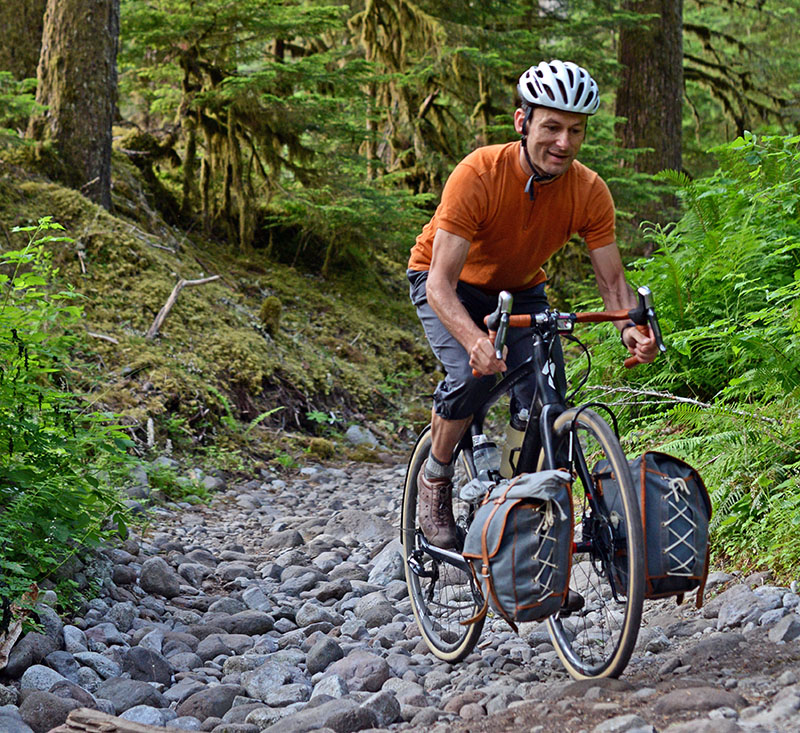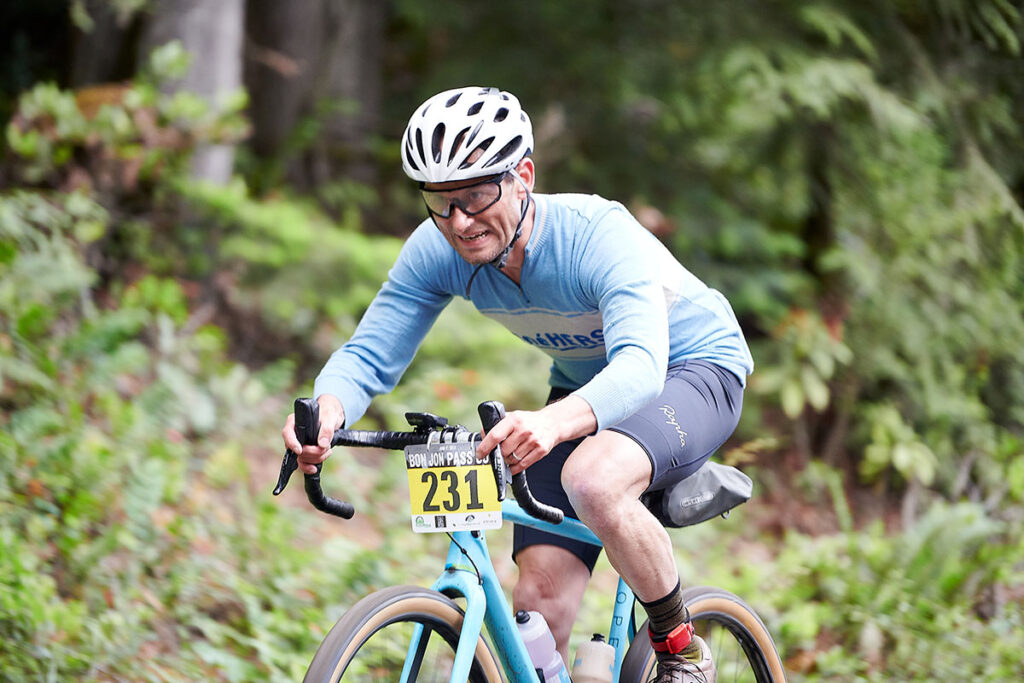Paris-Roubaix: One Bike for Everything?
This year’s Paris-Roubaix was a gripping race. With 60 km to go, Mathieu van der Poel launched a crushing solo attack and won the race at the fastest-ever speed, averaging 47.8 km/h. (That’s almost 30 mph!) It was bike racing at its best. Van der Poel was one of the favorites, and he delivered for the second year in a row.
This year’s race remarkable not just for its record speed, but also for the bikes that were ridden over the famous cobbles of the ‘Hell of the North.’ Every year, tech writers from all over the world descend on northern France to report about the special equipment that’s being rolled out for just this one race.

Past editions have seen suspension forks come and go (above in 1994). Full suspension bikes made brief appearances. There were strange frames with ultra-slack angles. Some riders rode cyclocross bikes. Others substituted forks from hybrid bikes (remember those?) to gain extra tire clearance. And the tires: There were plenty of tires marked hastily with sponsor’s logos in block letters, clearly showing that they were handmade tubulars in widths that the teams’ tire sponsors did not offer in their programs.
Every part of the bikes was optimized for durability and comfort. Frames had elastomer inserts. Bar tape was double- or even triple-wrapped. Some riders used bar plug inserts that were supposed to dampen vibrations. Paris-Roubaix wasn’t just a race, but also an annual geek-fest of bike tech.

Not so much this year. Van der Poel rode his Canyon Aeroad, the same bike he rides in other races. There were no apparent changes from the setup he uses for the rest of the season, not even double-wrapped bar tape. And he rode without gloves… The only obvious change was that he went up a tire size or two. Instead of 28 mm tires, he was on 32s. And he lowered the pressure a bit, to 52 psi (3.6 bar). That’s very close to what the Rene Herse tire pressure calculator would suggest as the ‘soft’ value for rough roads.
What’s remarkable here is not that the racers have changed over to normal racing bikes for Paris-Roubaix, but that today’s racing bikes are suitable for the ‘Hell of the North’ without modification—apart from simply putting on wider tires. To illustrate how much bikes have changed: When the American favorite, George Hincapie, ran a hybrid bike fork in 2006, it was to get extra clearance for 28 mm tires, which were considered huge at the time. (The fork broke during the race, but that’s another story.)
Van der Poel’s aero road bike clears 32 mm tires. Think about that for a moment! That’s close to the UCI limit for cyclocross (33 mm)—on an aero road bike. In fact, the Specialized Roubaix, a bike specifically designed for and named after this race, was sidelined this year. Specialized continues to sponsor many pro teams, but they all chose to ride their regular road bikes, the all-rounder Tarmac SL8. There’s simply no need for a special ‘Roubaix’ bike any longer.
That left the tech writers with nothing to report, apart from extra tape inside computer mounts to provide more friction and keep the units from falling off on the rough cobbles. (They still did, and Sam Welsford turned to Twitter, or whatever it’s called these days, to ask if you’ve found his Hammerhead.) Bottles were flying everywhere, except those of the riders who had opted for ‘old-fashioned’ metal cages. But those are just details—a far cry from the days when three-time winner Johan Museeuw showed up on a full-suspension bike.
All this doesn’t come as a surprise. The all-road bike revolution has made it possible: Pros can ride their Paris-Roubaix bikes all year, and so can we. In fact, the German title of our book ‘The All-Road Revolution’ translates to ‘One Bike for Everything.’ (All-road bike wasn’t yet a term that German cyclists were familiar with, so we decided to change the title.) Modern bikes are so versatile that there is simply no need for special equipment any longer just because a race goes over some cobblestones.
I should add a little note about the aero road bikes in Paris-Roubaix: In theory, the wider tires should have ruined van der Poel’s aerodynamics—the famous‘Rule of 105’ states that the rim should be at least 105% the width of the tire for aero wheels to provide a benefit. This would pair his Dura-Ace wheels with 26.7 mm tires. In practice, the wider tires doesn’t seem to have slowed him much. The biggest aero benefits come from reducing the frontal area of the rider, hence the recent move to narrow handlebars. And van der Poel certainly was low and aero on his bike as he powered to victory (above).

The idea of ‘One Bike for Everything’ extends much further than just racing. Add a set of low-rider racks and panniers, and you can take a modern road bike on a bikepacking trip. Above is the ground-breaking Specialized Diverge, one of the first carbon road bikes that could fit wide tires. When we tested it for Bicycle Quarterly, we took it on a camping trip to the end of the road on Tahoma’s (Mount Rainier’s) Carbon Glacier. And no, the photo isn’t posed or photoshopped, the road to Carbon Glacier is closed for cars because it has washed out in places. The river has deposited huge cobbles where the road once was. It was a little sketchy on those huge cobbles, but the bike (and tires) did just fine.
These days, you’d probably run bikepacking bags instead of panniers, but the idea is the same: Even for camping, you don’t need a special bike any longer. Back in 2014, the first Diverge was considered a gravel and adventure bike. Today, van der Poel’s aero road bike has almost the same tire clearances. (I’m on 32 mm tires above, just like the winner of Paris-Roubaix. That’s probably the only similarity between us…)

The bike I ride most these days is my OPEN × Rene Herse U.P.P.E.R. I race it on gravel, and I ride it on the road. It clears 48 mm-wide tires, and I usually run our dual-purpose knobbies on it. I don’t really bother to change anything about the setup, as I prefer riding over working on my bike. Even on familiar courses that are 100% paved, Strava shows that my times are no slower than they are on dedicated race bikes.
One Bike for Everything? It’s quickly becoming the reality for many of us. Of course, there have always been versatile bikes, but they weren’t race-winning machines. What’s new and exciting is this: Today we can enjoy road-bike speed and road-bike fun on all our rides. In the past, choosing wide tires and the ability to carry a load meant you rode a touring or mountain bike. You had to give up the nimble and responsive feel of a road bike as soon as you strayed from smooth pavement. Or you could try underbiking—riding your road bike in places for which it wasn’t intended.
Today, we no longer have to make those choices. Mathieu van der Poel can ride the same bike in smooth races and on the cobbles of Paris-Roubaix. And we can take our bikes everywhere, too, going faster and—more importantly—having more fun than we thought possible. One fun bike for everything—that’s the real revolution!

Further Reading:
-
- The All-Road Bike Revolution is our book that explains how modern bikes work and the science behind them: suspension losses, pneumatic trail and much more. If you’ve enjoyed this post, you’ll love the book!
-
- Bicycle Quarterly is our magazine where we publish cutting-edge research that continues to change our understanding how bicycles work. Plus inspiring adventures, fascinating history and thorough bike tests…
Photo credits: Jered Gruber (Photos 1, 3); John Pierce, Photosport International (Photo 2); Mark Vande Kamp (Photo 4); Daniel James (Photo 5); all used with permission.



